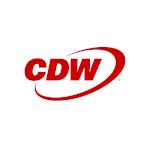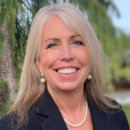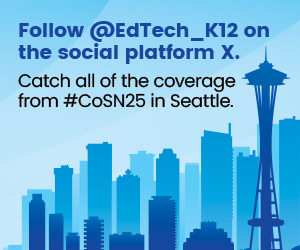Two IT leaders from the state, Clifton Dancy, director of information services and transportation coordinator for Derry Cooperative School District, and Josh Olstad, IT director at Oyster River Cooperative School District, spoke at CoSN 2025 about how they overcame challenges related to implementing technology initiatives in this environment.
To start, IT leaders across the state formed the NH CTO Council to bring together their expertise and find solutions to common K–12 challenges. Dancy said that this group was vital to his success at an IT leader, since he comes from a classroom background.
“You get in this job and suddenly you’re supposed to know about switches and wireless access points and VoIP phones and copy machines,” he said. “What we realized in talking about this was all of the different strengths we had. I didn’t know the network administrators felt just as intimidated by me because I knew curriculum as I was by them because they knew about network switches.”
The collaboration between New Hampshire districts also pushed the state to consider stronger data privacy. When a vendor wouldn’t sign a data privacy agreement, districts began ending their business with that vendor and moving to other solutions.
The next year, the vendor signed the DPA. Before long, the state was considering DPAs when it brought new standards and platforms to the table for schools to adopt.
RELATED: A partnership with CoSN aims to increase data privacy in Illinois.
Superintendents Make Decisions With an Eye Toward the Future
Superintendents are also driving change at the district level. In a CoSN 2025 panel Wednesday, Lake Stevens School District Superintendent Mary Templeton said she’s “trying to read the future so we’re not surprised” by tech innovations that arise. “What is your lens for the future, and how is technology, AI and the changing way that we teach inform our practice?”
Krestin Bahr, superintendent of Peninsula School District, said that schools must “act like a research facility.”
“Your school is a cultivating area,” Bahr continued. “You are educating the youth of America. Take that seriously.”
“The state of change is so rapid that we need to think five years ahead,” added Mineola Public Schools Superintendent Michael Nagler. “Trying to predict that and be thoughtful, particularly with AI, is our job.”
Examining the Priorities in CoSN’s Ed Tech Leadership Report
As they shared their advice about digital transformation Wednesday, the three superintendents also addressed priority areas of CoSN’s 2024 State of EdTech District Leadership report.
Artificial Intelligence
It’s hard to talk about evolutions in educational technology today without addressing AI. Not only is this technology changing the ways we teach and learn, it’s impacting nearly every other area of technology, from security to assignments.
KEEP READING: These are the artificial intelligence tech trends to watch in schools this year.
When it came to fielding AI in their own districts, Nagler and Bahr said they adapted their policies to incorporate innovation.
“In our tech policy, we erased the period and added ‘and AI.’ Then we put the period back,” Nagler said. “We also shifted from an acceptable use policy to a responsible use policy.”
Bahr found herself in a unique position as the leader of one of the first districts in the country to articulate guiding principles on AI following the release of ChatGPT. “It was developed with teachers and by teachers and with our technology experts and administrators in the district,” she said. “It is changing every year. It’s really written in pencil.”
Cybersecurity
Nagler understands the importance of cybersecurity. “I’ve been attacked twice. The first one was really bad. The second was not as bad, because we had more protections in place.”
Much of the time, cybersecurity breaches are caused by human error, he said, so his district started a cybersecurity class that will give students credentials when they complete it.
“Some of our state organizations have sent us things that look like phishing, so we send it back to them,” Bahr said, emphasizing the importance of identifying and flagging possible attacks.
Student Well-Being
To better understand and monitor student well-being, Templeton’s district uses Securly. “It is, in real time, processing what students are doing on their computers, and it’s alerting us.” She added that it can take a lot of work on the front end to have the right people in place to respond.
When it comes to students’ well-being and the high levels of anxiety many are contending with, Nagler said that people tend to blame screen time and technology. “I think adults are doing it to kids with the pressure we put on them in schools and the expectations that we have around grades and doing well,” he said. “On top of that, you can’t hide information from them. They see every bad thing that goes on in the world on their phones.”
Because schools can’t explicitly change what students are exposed to on their phones, Nagler notes, schools must help kids learn how to deal with it.
DIVE DEEPER: Make space for community and student well-being.
Digital Access
In Bahr’s district, half of which is in an extremely rural and under-resourced area, hotspots didn’t work as a solution for home connectivity. School leaders are still looking for a solution, but in the meantime, she said, “our students have Chromebooks and, in the school building, we have made sure they are extremely connected.”
“We really looked at the homework and assignments we were giving,” Nagler said. The district worked to ensure that these didn’t require intensive streaming and that they could largely be completed offline, even if the project required uploading when the student returned to school.
Templeton noted that much of the federal funding that helps schools ensure connectivity, like E-Rate, is at risk. “Our responsibility is to raise our voices around fairness,” she said.














